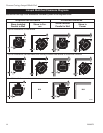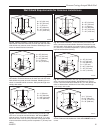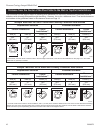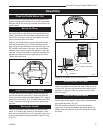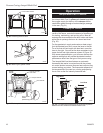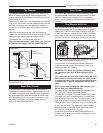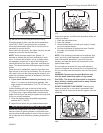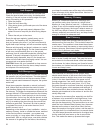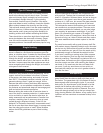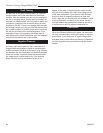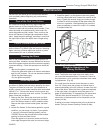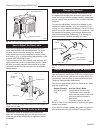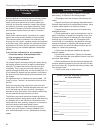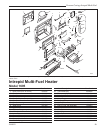
22
Vermont Castings Intrepid Multi-Fuel
2000970
Ash Disposal
Remove ash before it reaches the top of the ash pan.
Check the level at least once a day, and before each
refueling. If the ash is close to the top edge of the pan,
empty it according to this procedure:
1. Open the damper.
2. Open the front doors fully.
3. Using stove gloves, pull the ash pan out of the stove
by its handle.
4. Remove the ash pan and properly dispose of the
ashes. Be sure to keep the pan level during dispos-
al.
5. Return the ash pan to the stove.
Empty the ash pan regularly, typically every one to
three days. The frequency will vary depending on
how you operate your stove; if you burn more wood at
higher heat output settings, ash will accumulate rapidly.
Remove ash frequently and place it outdoors in a metal
container with a tight-fitting lid. Put the closed container
of ash on a noncombustible floor or on the ground,
well away from all combustible materials, pending final
disposal. If the ash is disposed of by burial in soil or
otherwise locally dispersed, keep it in the closed con-
tainer until all cinders have thoroughly cooled. You can
use wood ash as a garden fertilizer.
CAUTION: Never use your household or shop vacuum
cleaner to remove ash from the stove; always remove
and dispose of the ash properly.
Draft Management
A stove is part of a system, which includes the chimney,
the operator, the fuel, and the home. The other parts of
the system will affect how well the stove works. When
there is a good match between all the parts, the system
works well.
Wood stove operation depends on natural (unforced)
draft. Natural draft occurs when the smoke is hotter
(and therefore lighter) than the outdoor air at the top of
the chimney. The bigger the temperature difference, the
stronger the draft. As the smoke rises from the chimney
it provides suction or ‘draw’ that pulls air into the stove
for combustion. A slow, lazy fire with the stove’s air inlet
fully open indicates a weak draft. A brisk fire, supported
only by air entering the stove through the normal inlet,
indicates a good draft. The stove’s air inlet is passive;
it regulates how much air can enter the stove, but it
doesn’t move air into it.
Depending on the features of your installation - steel or
masonry chimney, inside or outside the house, matched
to the stove’s outlet or oversized - your system may
warm up quickly, or it may take a while to warm up and
operate well. With an ‘airtight’ stove, one which restricts
the amount of air getting into the firebox, the chimney
must keep the smoke warm all the way to the outdoors.
Some chimneys do this better than others. Here’s a list
of features and their effects.
Masonry Chimney
Masonry is a traditional material for chimneys, but it
can perform poorly when it serves an ‘airtight’ stove.
Masonry is a very effective ‘heat sink’ - it absorbs a lot
of heat. It can cool the smoke enough to diminish draft.
The bigger the chimney, the longer it takes to warm up.
It’s often very difficult to warm up an outdoor masonry
chimney, especially an oversized one, and keep it warm
enough to maintain an adequate draft.
Steel Chimney
Most factory-made steel chimneys have a layer of in-
sulation around the inner flue. This insulation keeps the
smoke warm. The insulation is less dense than mason-
ry, so the inner steel liner warms up more quickly than a
masonry chimney. Steel doesn’t have the good looks of
masonry, but it performs much better.
Indoor/Outdoor location
Because the chimney must keep the smoke warm, it’s
best to locate it inside the house. This uses the house
as insulation for the flue and allows a little heat release
into the home. An indoor chimney won’t lose its heat to
the outdoors, so it takes less heat from the stove to get
it warm and keep it warm.
Flue sizing
The inside size of a chimney for an ‘airtight’ stove
should match the size of the stove’s flue outlet. When
a chimney serves an airtight stove, more is not better;
in fact, it can be a disadvantage. Hot gases cool off
through expansion; if we vent a stove with a six-inch
flue collar (28 square inch area) into a 10 x 10” flue,
the gases expand to over three times their original size.
This cools the gases, which weakens draft strength. If
an oversized flue is also outside the house, the heat it
absorbs gets transferred to the outdoor air and the flue
usually stays cool.
It’s common for a masonry flue, especially one built for
a fireplace, to be oversized for an airtight stove. It can
take quite a while to warm up such a flue, and the re
-
sults can be disappointing. The best solution to an over-
sized flue is an insulated steel chimney liner, the same
diameter as the stove or insert’s flue outlet; the liner
keeps the smoke at its original volume, and the result is
a stronger draft. An uninsulated liner is a second choice
- the liner keeps the smoke restricted to its original size,
but the smoke still must warm up the air around the
liner. This makes the warm-up process take longer.



